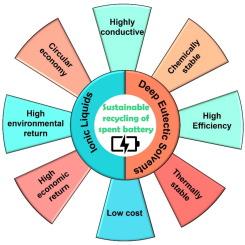Critical metal extraction from spent battery cathodes and anticipated developments using next generation green solvents for achieving a net-zero future
IF 13.3
1区 工程技术
Q1 ENGINEERING, CHEMICAL
引用次数: 0
Abstract
The global shift towards decarbonizing the energy sector necessitates the extensive adoption of efficient electrical storage systems, such as Lithium-ion and Nickel-metal hydride batteries. However, these spent batteries pose significant global challenges due to the loss of critical materials and environmental pollution. Effective recycling of spent batteries mitigates pollution, conserves valuable resources, and enhances sustainability. Sustainable battery design involves implementing innovative technologies that promote the efficient and eco-friendly recycling of waste batteries to recover the critical metals. Integrating next-generation green solvents such as ionic liquids and deep eutectic solvents into battery recycling becomes essential to meet the growing demand for critical metals as well to achieve environmental sustainability. This review provides recent technical advances of conventional recycling processes, systematically reviewing the pyro-and hydro- metallurgical processes and emphasized the role of next-generation green solvents in the development of sustainable recycling processes. To further highlight the potential benefits of the new process in terms of its green, low-carbon, low-energy consumption, and reduced toxicity profile, we conducted a comparative analysis of key environmental indicators between conventional and novel processes, emphasizing the role of innovative solutions in promoting sustainable and efficient recycling for a net-zero future.

求助全文
约1分钟内获得全文
求助全文
来源期刊

Chemical Engineering Journal
工程技术-工程:化工
CiteScore
21.70
自引率
9.30%
发文量
6781
审稿时长
2.4 months
期刊介绍:
The Chemical Engineering Journal is an international research journal that invites contributions of original and novel fundamental research. It aims to provide an international platform for presenting original fundamental research, interpretative reviews, and discussions on new developments in chemical engineering. The journal welcomes papers that describe novel theory and its practical application, as well as those that demonstrate the transfer of techniques from other disciplines. It also welcomes reports on carefully conducted experimental work that is soundly interpreted. The main focus of the journal is on original and rigorous research results that have broad significance. The Catalysis section within the Chemical Engineering Journal focuses specifically on Experimental and Theoretical studies in the fields of heterogeneous catalysis, molecular catalysis, and biocatalysis. These studies have industrial impact on various sectors such as chemicals, energy, materials, foods, healthcare, and environmental protection.
 求助内容:
求助内容: 应助结果提醒方式:
应助结果提醒方式:


